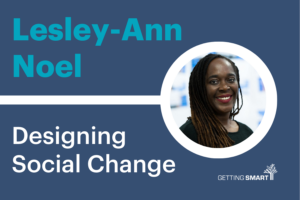For Deeper Learning, Transform Schools Into Leadership Machines

Bryan C. Hassel & Emily Ayscue Hassel
Finding enough great school leaders was challenging enough when learning basic skills was the goal. Expecting schools to achieve Deeper Learning raises the ante. We’re kidding ourselves if we think schools and districts—designed the way they are today—can fill a pipeline with great leaders of Deeper Learning.
Why can’t today’s one-teacher-one-classroom design work for Deeper Learning at scale? Because districts expect principals to be “instructional leaders,” helping 30 or more teachers each achieve instructional excellence. Combined with the other roles a school leader must play, that’s a responsibility few execute well. Too few gain leadership experience before the principalship, and the number of teachers they lead is too large to help each one improve on the job. Then, the best leaders often earn “promotions” into the central office, where they are somehow expected to ensure the success of 30 or 40 schools. None of this worked very well in the era of basic learning. It’s a train wreck in the era of Deeper Learning.
If we’re serious about school leadership for Deeper Learning, we need a new model. That model needs two key components: a model for within-school leadership that fosters deeper learning and creates a pipeline of school leaders and instructional team leaders to support them, and a model for multi-school leadership that enables the best school leaders to expand their impact. Digital learning is critical to within-school leadership and multi-school leadership, because it both frees time for leaders and teams to collaborate and provides data needed to grasp the individual needs of more students. We’ll share more detail in the forthcoming An Excellent Principal for Every School: Transforming Schools Into Leadership Machines. Meanwhile, Getting Smart readers get a preview.
Within-school leadership. Today’s school model is essentially “every teacher for herself.” Despite “professional learning communities” and lip service to collaboration, teaching is largely a solo profession. What if, instead, schools organized around teams, with excellent teachers leading their peers and taking responsibility for the deeper learning of all the students served by the team? These “multi-classroom leaders” could continue to teach, but extend their reach to more students and their peers.
The payoff would be twofold. First, the school leader’s job would change in ways that make it, for the first time, possible to lead a whole school toward deeper learning. Rather than spot-checking the work of 30-plus teachers, the school leader’s role would shift to managing a team of multi-classroom-leaders, each responsible for the teachers and students in one or more subjects or grades. Leading six teacher-leaders who develop excellent Deeper Learning on the job with their teams—that sounds like a role school leaders could successfully play.
Second, if every school had this cadre of multi-classroom leaders truly accountable for student learning across a team of teachers, districts would enjoy a dramatically enhanced pipeline of school leaders. While many multi-classroom leaders would want to keep teaching, some would move into school leadership. And they would do so with the preparation few school leaders obtain today—learning on the job how to lead teaching excellence.
School leaders rising from the multi-classroom leader ranks would already be well-versed in what schools need their leaders to do: set high, clear expectations for team performance, including students’ Deeper Learning; see the strengths and challenges of team members and craft roles accordingly; provide real-time, on-the-job development for team members; and model instructional planning and teaching excellence. Districts would have access to a vastly expanded pipeline of proven leaders.
Multi-school leadership. A school leader’s career path can go beyond the principalship: Great school leaders could move up to lead multiple schools. We’re not talking about “leading” 30 or 40 schools the way many urban principals’ supervisors do today. Instead, we mean leading two schools, then three, then five or more, expanding their impact but remaining close enough to interact deeply with individual school leaders and the multi-classroom leaders at the core of their schools. In short, multi-school leaders could continue doing what they’ve done best as school leaders, working with a small cadre of other leaders to make Deeper Learning happen daily for students and teachers.
A new model of leadership. These two ideas—multi-classroom leadership and multi-school leadership— create a career pathway that looks much more like what top performers and leaders enjoy in other professions. They can advance throughout their careers without leaving direct, operational responsibility for students. And together, they create an organization design that can work for Deeper Learning. Because schools would be led not just by principals, but by teams of multi-classroom leaders, top-notch school leaders could more easily move up into roles where they are responsible for multiple schools.
Changing school and district designs also opens up possibilities for reallocating dollars to pay teachers and leaders far more for added responsibilities in the era of Deeper Learning. More than 50 schools involved in the Opportunity Culture initiative are already creating teacher-led teams and paying multi-classroom leaders substantially more—as much as 50 percent above average pay—by reallocating existing funds, rather than relying on temporary grants.
Schools and districts using multi-school leadership models could reallocate dollars to pay school principals and multi-school leaders more, too. If they do, and also support them with strong cadres of multi-classroom leaders, the principalship will attract far more of our nation’s most talented leaders than ever—exactly what’s needed to meet the challenge of Deeper Learning.
This post is part of our “Preparing Leaders for Deeper Learning” series. If you have thoughts about what today’s school leaders should know and be able to do and how they should be prepared, we’d love to hear from you. Contact [email protected] with the subject “Preparing Leaders” for more information.
To learn more about preparing leaders, see:
- Design Thinking Course Trains Future EdLeaders
- How Should Principals Be Trained? Like MBAs? Like CEOs?
- Leadership Mindsets for Breakthrough Leaders
 Dr. Bryan C. Hassel & Emily Ayscue Hassel are co-directors of Public Impact. Follow them on Twitter: @BryanHassel and @OppCulture.
Dr. Bryan C. Hassel & Emily Ayscue Hassel are co-directors of Public Impact. Follow them on Twitter: @BryanHassel and @OppCulture.

0 Comments
Leave a Comment
Your email address will not be published. All fields are required.